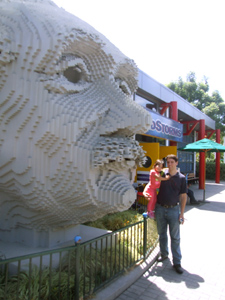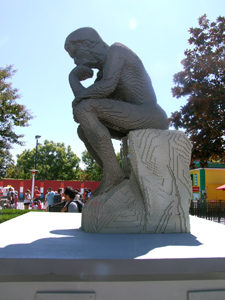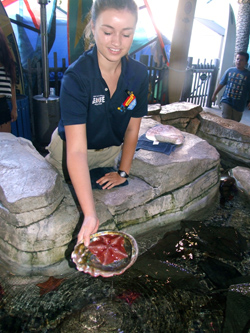

David and Sara Harrison admire giant head of Einstein at Legoland California Resort. An homage to
Auguste Rodin’s “Thinker” reinforces the Lego Company’s celebration of the mind
By Donald H. Harrison

CARLSBAD, California – The Legoland California Resort here may be among the few places in the world where you can meet, after a fashion, a person regarded by many people as one of the smartest men ever to have lived, and just a short stroll away, some of the world’s absolutely brainless creatures.
You might say that the exhibits here cover the intellectual spectrum.
At the top of the scale—so far as anyone knows—is Albert Einstein, the world-renowned Jewish physicist who died in 1955 at age 76 after astounding the world with his general theory of relativity and devising a formula that many school children still take pleasure in repeating: “Energy equals mass times the speed of light squared.”
A giant head of Einstein was constructed with more than one million Legos, according to guide Jamee Rogan. The giant head sits outside the attraction “Mind Storms,” in which parents and children alike are invited to use computers to control robots in two different scenarios: in one they perform a surgical operation, and in the other they seek archaeological artifacts.
Robots fire our imaginations, and Lego blocks prompt within us desires to build amazing creations. Here children, and maybe even adults, can imagine themselves as scientists, inventors, engineers, and creators. Another sculpture in the park, modeled after “The Thinker” by Auguste Rodin, also celebrates the possibilities of the mind–perhaps one’s future lies in being a philosopher, a sociologist, a writer, or a teacher!
One finds Einstein’s opposites, the creatures with apparently no intellects at all, at Legoland’s Sea Life Aquarium. One such animal is the jellyfish. In a Discovery Room within the aquarium we learn that “the jelly fish has no heart, no brain, no true eyes. Some have sensory organs able to perceive light and no central nervous system. Inside their bell-shaped body is an opening that is the mouth. They eat and discard waste from this one opening….”
Eat and discard waste from the same opening? If a jellyfish were human, you couldn’t think of a more brainless idea.
Farther into the multi-roomed exhibit, one comes to a tide pool where one encounters, among other species, a sea cucumber — which, notwithstanding its name, is an animal, not a vegetable.
Ready to answer questions on the day we visited was Kerstin Ozkan, who found herself a perfect summer job at the aquarium. During the rest of the year she is a student of Wildlife, Fish and Conservation Biology at UC Davis.

Not only do the sea cucumbers lack brains, she informed us, “their defense system is kind of gross; they squeeze out their internal organs, from out of their heads or their bottoms. The predators go for the guts and leave the sea cucumbers alone.”
Unlike humans, sea cucumbers can do without their internal organs for a while. “They can regrow them,” according to Ozkan.
The guide also showed to us a bat star that she had placed inside an abalone shell. Like the jellyfish and the sea cucumbers, she said, “the sea stars have no brains” and, furthermore, “their blood is filtered sea water. They each have little eye spots at the end of each arm and this helps them sense in the dark.”
At Legoland, they call interesting bits of information about sea creatures “fin facts.” At yet another stop within the aquarium, guide Deborah Warren shared a “fin fact” about the Queensland Grouper, a fish that can live up to one hundred years and can grow to between 800 and 1000 pounds.
The grouper in Legoland’s tank was but a baby, only three years old. “Queenie,” as she is nicknamed, will remain a female until about her 50th year and then will transform herself into a male –a peculiarity of her species.
At that point, “she’ll become a Kingsland Grouper,” suggested my 13-year-old grandson, Shor.
Before leaving the Sea Life Aquarium, we admired an exhibit of sea horses where we learned that “female sea horses use a special tube called an ovipositor that puts eggs into a pouch of a male where the eggs are fertilized.”
I bet there are a lot of human women who would like that idea!
While we may make a big deal about the intellectual gap between Einstein and various forms of sea life, Einstein, himself, probably would have dismissed the difference as unimportant.
He has been quoted as saying: “Everybody is a genius. But if you judge a fish by its ability to climb a tree, it will live its whole life believing that it is stupid.”
*
Harrison is editor of San Diego Jewish World. He may be contacted via donald.harrison@sdjewishworld.com